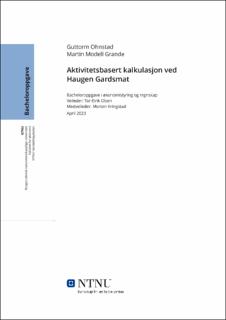| dc.description.abstract | I denne oppgaven har vi tatt utgangspunkt i den familiedrevne virksomheten Haugen Gardsmat og deres satsning innenfor dagligvare. Sektoren er svært konkurranseintensiv, og ledelsen ser det nødvendig å ha god kontroll på sine kostnader for å kunne sikre lønnsomhet samt et grunnlag for prispolitiske beslutninger. Vi formulerte derfor denne problemstillingen: Kan aktivitetsbasert kalkulasjon hjelpe Haugen Gardsmat til å bedre vurdere lønnsomheten i sin portefølje av ferdigmat?
I teorikapittelet introduserte vi aktivitetsbasert kalkulasjon som en god modell for å måle ressursbruken til et objekt. I den videre oppgaven valgte vi en praktisk tilnærming da dette vil maksimere virksomhetens utbytte så vel som gi oss et tydeligere innblikk i kalkylesystemets presisjonsnivå i møte med den virkelige verden. Derfor utarbeidet vi en fullstendig ABC-kalkyle for avdeling dagligvare og produktet Sognalapskaus.
Vi startet med å se på dagens kalkyle. Kalkylen baserer seg på bruttofortjeneste-metoden og gir kun informasjon om direkte materialkostnader samt frakt. Det vil i all hovedsak si råvarekostnad og emballasje. Råvarekostnaden var heller ikke helt fullstendig ettersom den baserte seg på flere varer som ikke var prissatt til full tilvirkningskost.
I ABC kalkylen gikk vi frem og avklarte først samtlige direkte kostnader. Disse utgjorde direkte material, direkte lønn og direkte energi. Deretter definerte vi aktivitetene med sine tilhørende kostnader. Vi fant passende kostnadsdrivere for hver aktivitet og definerte drivervolumet basert på praktisk kapasitet. Ved å måle antall driverenheter Sognalapskaus stod for kunne vi til slutt fordele en rekke indirekte kostnader til produktet. Disse bestod blant annet av energikostnader, vedlikehold, indirekte lønn, reisekostnader, transportkostnader, avskrivinger, kalkulatorisk rentekost og mange flere.
Datagrunnlaget var ikke det enkleste å arbeide ut fra og vi måtte gå svært nøye til verks for å måle og estimere ressursforbruket i de enkelte aktivitetene. Detaljnivået ble høyt og driverne forklarte med høy presisjon kostnaden i aktiviteten. Vi kunne dermed konkludere med at ABC-kalkylen tilbyr Haugen Gardsmat et svært mye bedre grunnlag for å vurdere lønnsomheten i sin portefølje av ferdigmat enn dagens kalkyle. | |
| dc.description.abstract | In this thesis, we have based our research on the family-owned business Haugen Gardsmat and their focus on the grocery sector. The industry is highly competitive, and the management sees it necessary to maintain high control over their costs to ensure profitability and a sufficient foundation for a good pricing policy. Therefore, we formulated this research question: Can activity-based costing help Haugen Gardsmat to better assess the profitability of their portfolio of convenience food?
In the theoretical chapter, we introduced activity-based costing as a good model for measuring the resource usage of an object.
We chose a practical approach as this would maximize the company's benefits as well as give us a clearer insight into the precision level of the costing system when applied to the real world. Therefore, we developed a complete ABC calculation for the product "Sognalapskaus." and the grocery department.
We started by looking at the current calculation method, which is based on the gross profit method and provides information only on direct material costs and freight. This mainly includes raw material costs and packaging costs. The raw material cost was also not completely accurate as it was based on several items that were not priced at full manufacturing cost.
In the ABC calculation, we first identified all direct costs, which included direct materials, direct labor, and direct energy. Then, we defined the activities with their corresponding costs. We then found suitable cost drivers for each activity and defined the driver volume based on practical capacity. By measuring the number of driver units "Sognalapskaus" represented, we could finally allocate a range of indirect costs. These costs included energy, maintenance, indirect labor, travel, transportation, depreciation, imputed interest costs, and many more.
The data was not the easiest to work with, and we had to be very careful in measuring and estimating resource consumption in each activity. The level of detail was high, and the drivers explained the cost of the activity with high precision. Therefore, we could conclude that ABC costing provides Haugen Gardsmat with a much better foundation for assessing the profitability of their portfolio of convenience food. | |
